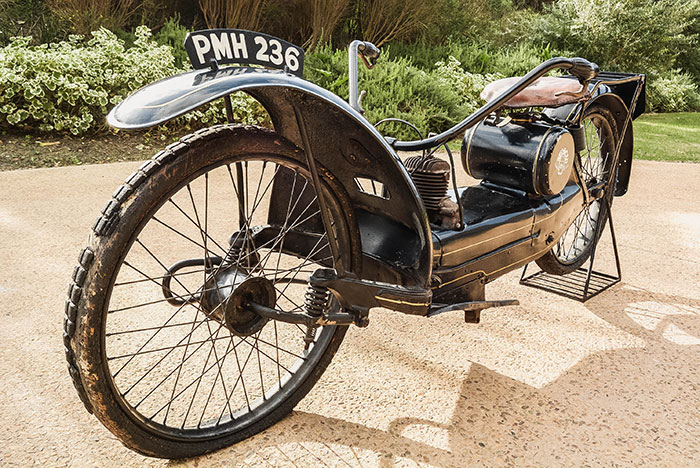
29 Jun On yer bike – Ner-A-Car
Well, not quite… This month, for a change, Mike and Wendy Monk take over the column for a look at one of the more interesting old motorcycles tucked away in the FMM storeroom awaiting some TLC to get it up and running again…
The Ner-A-Car was a type of feet-forward motorcycle designed by Carl Neracher in 1918. It used an unusual pressed-steel-channel chassis, much like a car, and hub-centre steering at the front wheel, making it ‘nearly a car’ in design, a description from which the bike’s name is derived, although it is also a play on the designer’s name. Take your pick… The Ner-A-Car was the most successful hub-centre steering motorcycle ever produced. About 10 000 were manufactured in the USA under the Neracar name by the Ner-A-Car Corporation, while around 6 500 are believed to have been produced in England under licence by the Sheffield-Simplex company between 1921 and 1926 as a Ner-A-Car.
Apart from the unusual steering set-up, Neracher’s radical design had several unusual features including a low-slung, long-wheelbase perimeter frame, all-enclosing bodywork, a feet-forward riding position, and a friction drive transmission driven by the flywheel off the engine. The bike’s frame design and double-leading-arm front suspension helped create low centre of gravity that offered exceptional stability. There was no rear suspension. Tyres were 26×3-inch and braking was via drum. Dry weight was around 175 pounds (385 kg).
The friction-drive transmission was similar in concept to a continuously variable transmission that can be found on a number of today’s cars. The bike’s CVT had five fixed indents on the shift lever that corresponding to pre-set drive ratios. The driven friction wheel was moved between the centre and outer rim of the flywheel to effect a change in drive ratio; nearer the centre was a ‘lower’ speed, farther towards the rim of the flywheel was the ‘higher’ speed. The design was simple and ingenious, with a feeling nearly like an automatic transmission.
A group of investors funded the Ner-A-Car Corporation, which began production of Neracars in October 1921 in Syracuse, New York, by which time Neracher had licensed his design to Sheffield-Simplex to manufacture Ner-A-Cars for the British and Commonwealth markets. The bike was marketed as a low cost alternative to a motor car. The advertisers publicised the Ner-A-Car’s step-through design and its protection from road grime and engine fluids, both of which allowed riders to wear ordinary clothes, including skirts, cassocks and kilts…
The Ner-A-Car Corporation made three models: the Type A had solo seating, the original 221 cm3 two-stroke 2,5 hp engine, one headlight, and one tail-light. The Type B had a larger engine, two seats, and two headlights. A commercial version, the Type CB, had a pair of headlights, a pair of drum brakes on the rear wheel, and a steel utility box rated to carry 150 pounds. In the US, a 255 cm3 model was introduced in 1924, and a five-speed Neracar was advertised as a Christmas Special for $175 in November 1927. The bike was advertised as having a top speed of 35 mph (56 km/h) and a fuel consumption of 85-100 mpg 2,7-2,4 litres/100 km). Production of the Neracar ended in 1927.
British licensee Sheffield-Simplex began production of Ner-A-Cars in Kingston-upon-Thames in 1921 along with the original American design. The FMM bike is believed to be a 1922 model. In 1923 the engine was enlarged to 285 cm3. Then in 1925 the company developed a new version, called Model C, with a Blackburne four-stroke side-valve engine, displacing 348 cm3, driving through a three-speed Sturmey-Archer manual transmission. The earlier model continued as the Model B and a Sports C, with an overhead-valve version of the Model C engine, was also offered.
A de-luxe model was introduced in 1926 with a windshield, instrument panel and swing-arm rear suspension controlled by quarter-elliptic leaf springs, a bucket seat with air cushions, and a fairing with an adjustable Triplex windshield and an instrument panel. A countershaft, concentric with the swing arm pivot, was driven by a chain from the transmission and drove the rear wheel. The addition of rear suspension increased the wheelbase of the de-luxe model from 59 inches (1 500 mm) to 68,5 inches (1 740 mm). Production of the Ner-A-Car at Sheffield-Simplex ended in the autumn of 1926.
During its short but productive life span, to demonstrate the bike’s reliability, Erwin G ‘Cannonball’ Baker rode a Neracar from Staten Island, New York, to Los Angeles, California, in the autumn of 1922. The journey of 3 364,4 miles (5 414,5 km) took 174 hours and one minute to complete, with operating costs totalling $15,70. The Ner-A-Car won several medals for reliability in long-distance road trials, including the team prize in the 1925 ACU 1000-mile Stock Machine Trial.
A fascinating machine that was a forerunner to future top-of-the-range models from both Yamaha and Bimota.



